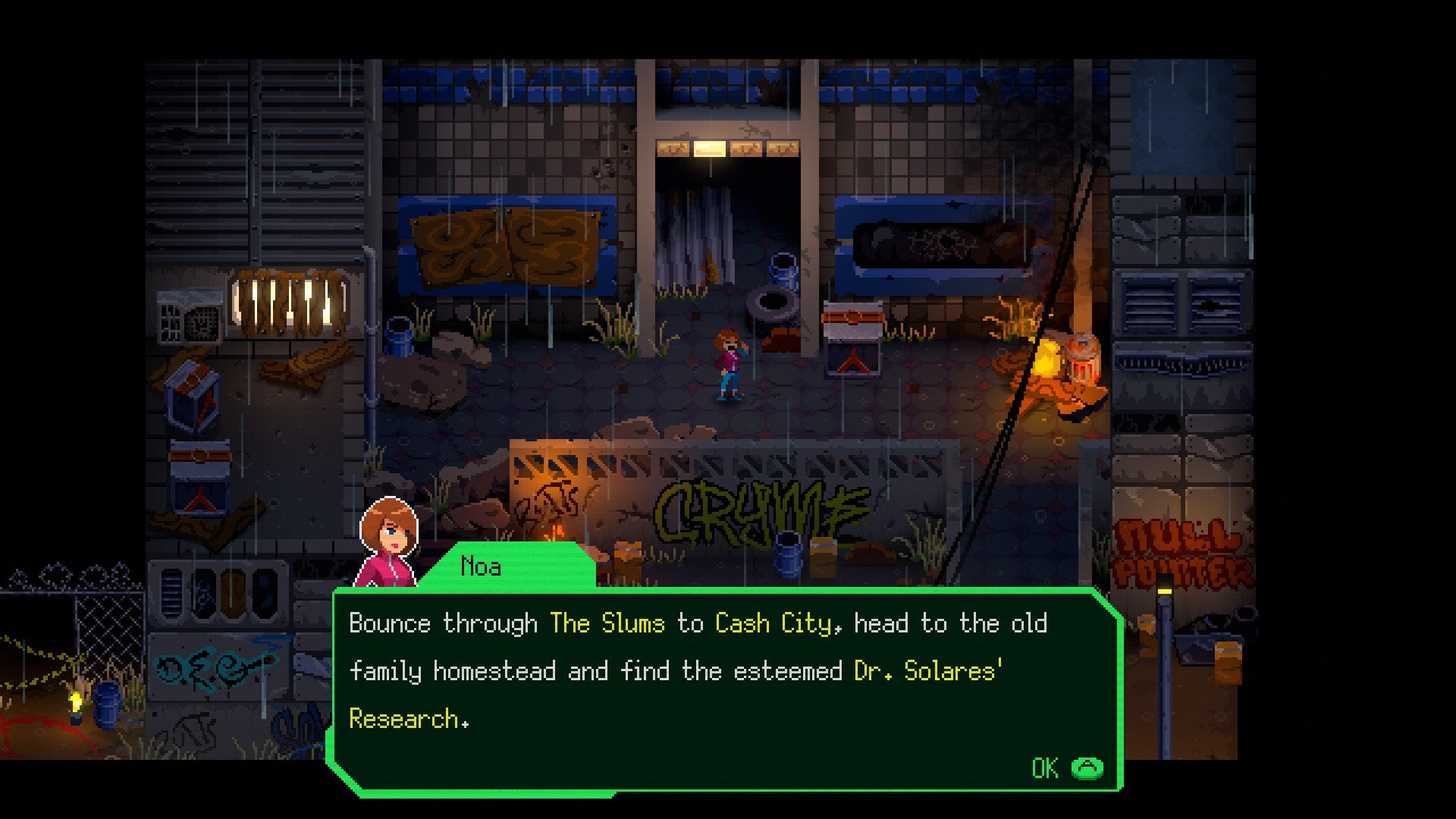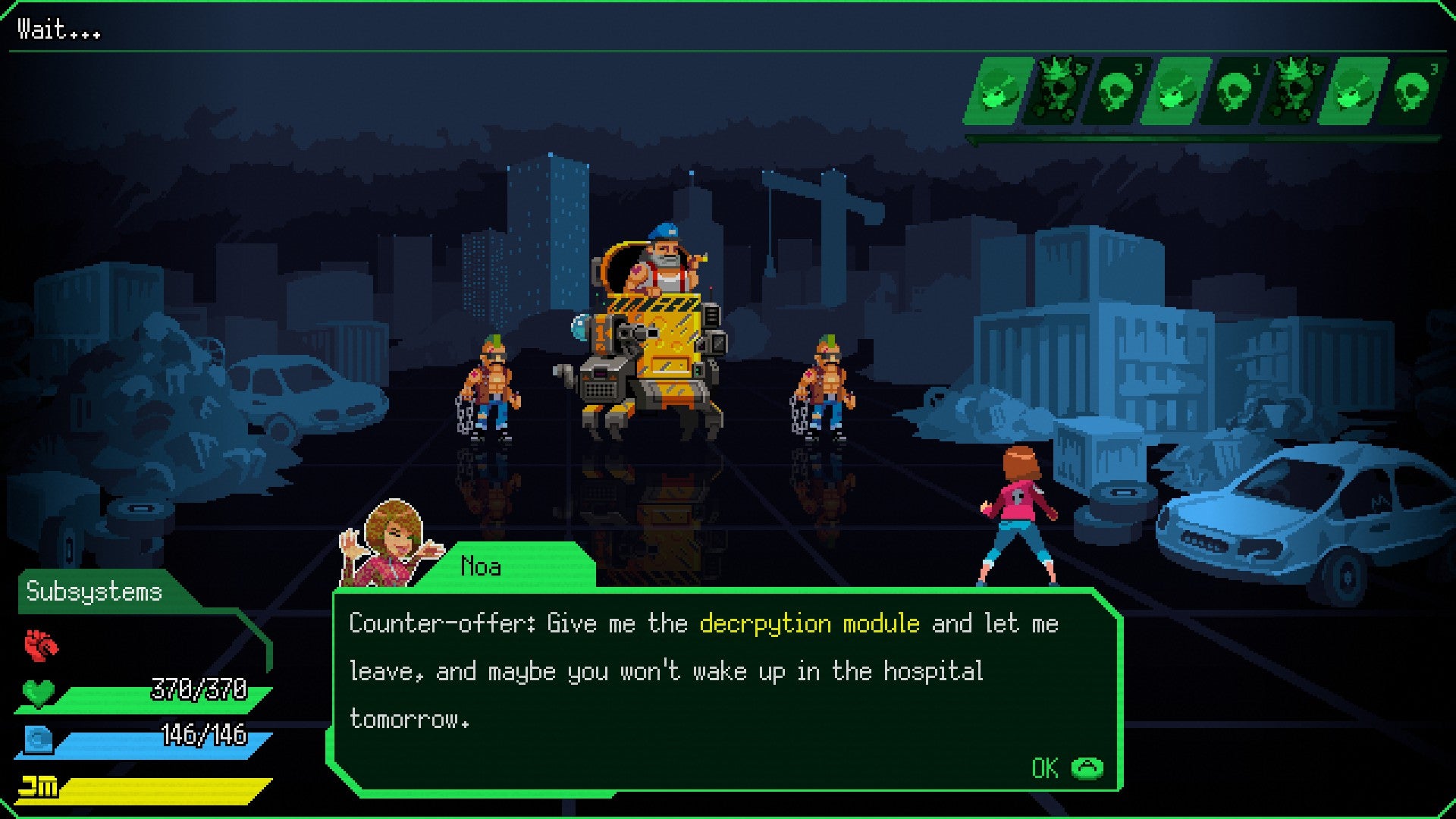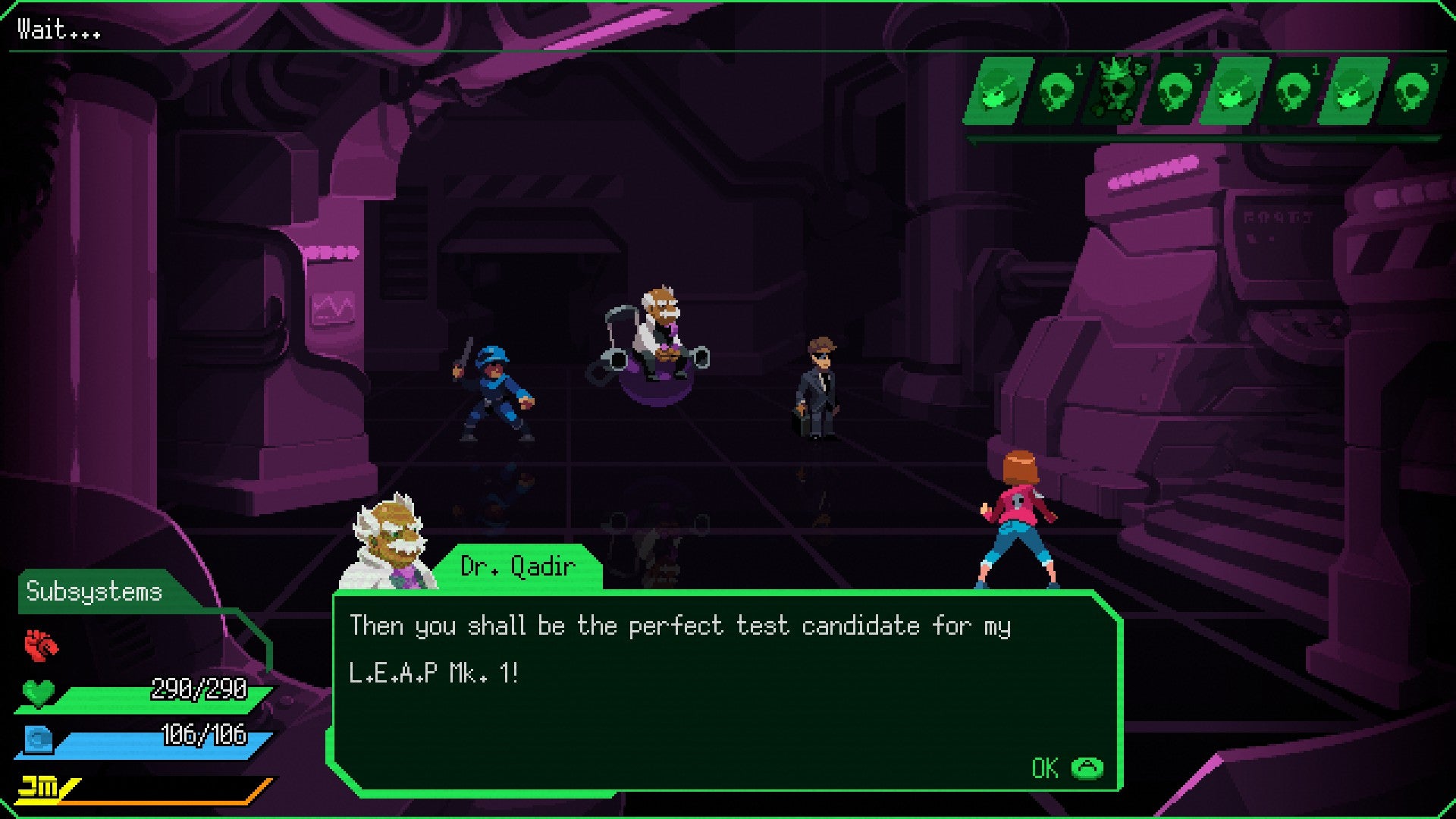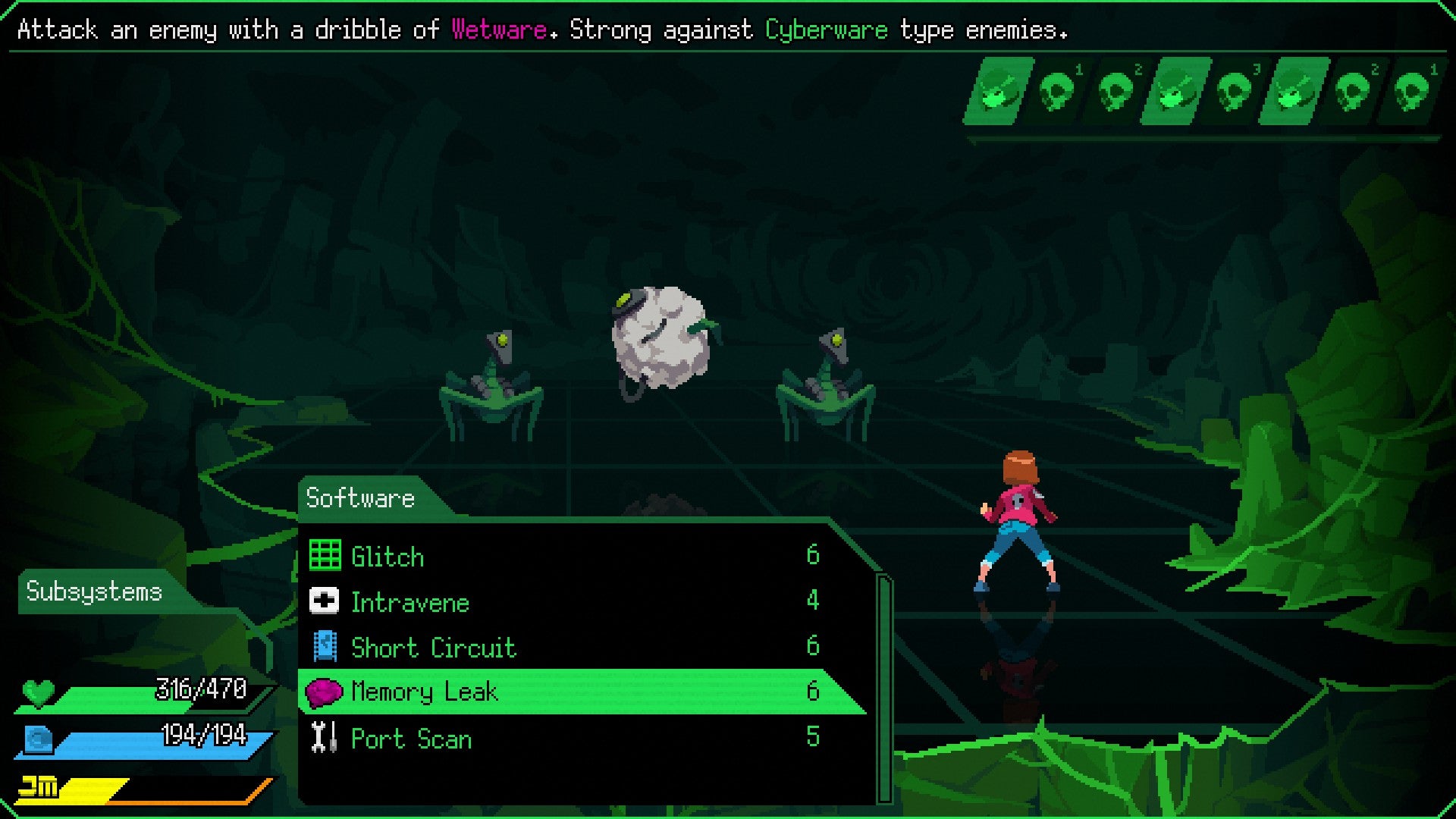But the bigwigs at MonoMind aren’t out to poison the world and suck the life from it in Jack Move. Instead, they’re more concerned with using their newfound technological powers to find eternal life – a classic ‘upload your mind to the metaverse’ kind of tale you’ll probably recognise if you’ve read any of the cyberpunk 101 novels such as William Gibson’s Neuromancer or Permutation City by Greg Egan. Jack Move’s story doesn’t tread any new ground in this respect, but Noa and her hacker pal Ryder are a fiery spirited pair that make this six-hour tale of espionage and rebellion against its cartoonish villain well worth dipping into. Yes, you read that correctly. A JRPG you can polish off in a single day of play. Bliss. Aside from its manageable length, the other ace Jack Move has up its sleeve is its absorbing battle system. While the bulk of the game gives you a top-down view of Noa’s hometown, battles take place over the shoulder in a kind of Tron-like virtual realm for some stylish ‘cyber clashes’. I think the idea is that Noa’s foes are technically trying to hack her brain (the game never really does explain itself very well on this front), as you don’t ever see most of them in the world around you. Rather, the Yu-Gi-Oh-esque cyberspace deck Noa carries around on her arm has a threat level meter that, when full, means enemies can attack you at any time. Random encounters by another name, in other words. However it’s dressed up, though, it works, with wonderfully detailed battle animations bringing an extra layer of visual relish. Tech heads will no doubt appreciate all the hardware references peppered through the rest of its menus, too. Melee attacks are referred to as ‘hacks’, for example, while your special abilities are all bits of ‘software’ you’ll need to ’execute’ using your available ‘data’ (or magic points, if you’re after a more traditional reference). These software modules fall into cyberware, electroware and wetware attacks, which are all governed by a simple rock paper scissors system. In a particularly cute nod, ‘patching’ also allows you to use items such as healing packs, and you can ‘cache’ a turn to delay it until later in the turn order, giving yourself a nice little defence boost while you wait. The more you attack, the more you build up your titular Jack Move meter as well, which lets you dole out devastating Limit Break-style specials to everything onscreen. These are pure Final Fantasy, right down to the three little QTE button prompts you’ll need to perform to determine the overall strength of the attack, and much like said Final Fantasy games, they bring a welcome sense of rhythm and flair to the overall flow of combat. Combined with its fluid battle animations and detailed spritework, these cyber clashes are just good, old fashioned fun. They tick all the right boxes in my JRPG brain, and I looked forward to each and every scrap. The tech chat extends to the rest of Jack Move’s underlying systems as well, as you only have a limited amount of RAM (i.e: slots) to install your software attacks in, for example (think Resident Evil inventory Tetris meets Pokémon’s four-way moveset), and you also have a dedicated Hardware menu for equipping three extra ’expansion’ abilities. These range from specific stat buffs and giving you scanning or counterattack options, and you can even use them to temporarily increase your number of available RAM slots (which you can upgrade permanently if you stump up the cash for them). As someone who enjoyed all the techno babble in last year’s Narita Boy, I got a real kick out of all this, but I can also imagine those who are less tech savvy being completely bewildered by it. That, or finding it rather twee. For me, though, I quite liked these cyberpunk riffs on your typical JRPG framework, as they not only give it a sense of character, but they also make everything feel grounded in the wider world of the game. The best twist it brings to the Final Fantasy playbook, however, is also sadly its most woefully underused. Your RAM slots may limit the number, type and breadth of attacks you’re able to bring into combat, for example, but you can also opt to give up your turn to ‘install’ other bits of software, effectively allowing you to switch up your battle strategy on the fly. This is such a neat idea, potentially paving the way for tricky, mercurial boss battles that bring the full force of Jack Move’s ability set to bear, but the game’s over-reliance on its basic rock-paper-scissors system meant I never really felt the need to switch up my strategy. Balance issues may be the bug in the system here, as I breezed through a lot of the game with the most basic forms of its three software specials, only switching up to the second tier (of three) about two thirds of the way through – long after I’d met the level gate requirement. On the plus side, I didn’t have to do any grinding during my playthrough -except when I eventually met the final boss, which had such a sharp difficulty spike that ended up taking me well over an hour (and failed several attempts) to actually take down. It’s a shame Jack Move doesn’t make better use of its RAM swaps, but also entirely understandable given the size and scope of the studio. This has largely been a solo endeavour for lead developer Edd Parris over the years, and what’s here is still an admirable achievement given its high level of polish. I just hope So Romantic get to build on these ideas in the future, as Jack Move feels like the start of something special – and certainly a cut above many of the other Japanese-style RPG pretenders I’ve endured over the years as well. I’d love to see what it looks like with a bit of balance tuning, but it’s still worth a look regardless, especially when there’s a free demo on you can try on Steam. If you’re looking for a small Final Fantasy VII-style fix that will whisk you back to 1997 again before Crisis Core - Final Fantasy VII - Reunion comes out later this year, Jack Move should slot into your gaming library very nicely indeed.




